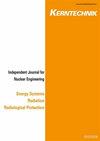Model of terminal debris bed formation after a CANDU core collapse
IF 0.4
4区 工程技术
Q4 NUCLEAR SCIENCE & TECHNOLOGY
引用次数: 0
Abstract
Abstract A CANDU reactor core comprises several hundred horizontal fuel channels spanning a calandria vessel. Loss of sufficient cooling during a severe accident could result in collapse of the core to the bottom of the calandria. A simple computational tool for simulating, in two dimensions, the resulting build-up of a terminal debris bed is described. The tool is used to model a variety of core collapse scenarios. Computed debris beds are generally lower in the middle, ∼10 fuel channels deep, and have higher decay power in their interiors. The initial debris bed porosity is estimated to be 0.65 ± 0.15. High porosity could augment in-vessel hydrogen generation and fission product release during subsequent debris bed heat-up.CANDU岩心崩塌后末端碎屑床形成模型
摘要CANDU反应堆堆芯由数百个横向燃料通道组成。在严重的事故中,如果没有足够的冷却,可能会导致堆芯坍塌,直至堆底。一个简单的计算工具,用于模拟,在二维,最终建立一个终端碎片床描述。该工具可用于模拟各种岩心坍塌场景。计算出的碎屑层通常在中间较低,约10个燃料通道深,并且在其内部具有较高的衰变功率。初步估算碎屑床孔隙度为0.65±0.15。高孔隙度可以增加后续碎屑床加热过程中容器内氢气的生成和裂变产物的释放。
本文章由计算机程序翻译,如有差异,请以英文原文为准。
求助全文
约1分钟内获得全文
求助全文
来源期刊

Kerntechnik
工程技术-核科学技术
CiteScore
0.90
自引率
20.00%
发文量
72
审稿时长
6-12 weeks
期刊介绍:
Kerntechnik is an independent journal for nuclear engineering (including design, operation, safety and economics of nuclear power stations, research reactors and simulators), energy systems, radiation (ionizing radiation in industry, medicine and research) and radiological protection (biological effects of ionizing radiation, the system of protection for occupational, medical and public exposures, the assessment of doses, operational protection and safety programs, management of radioactive wastes, decommissioning and regulatory requirements).
 求助内容:
求助内容: 应助结果提醒方式:
应助结果提醒方式:


